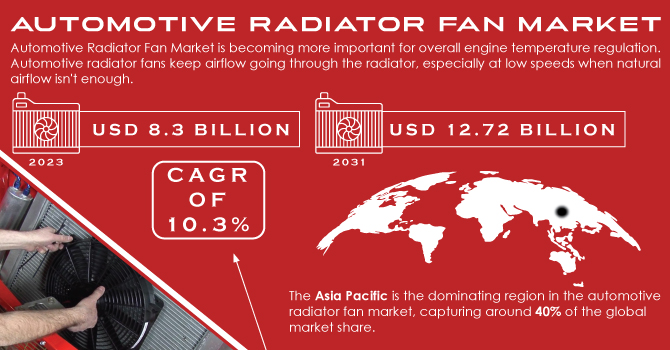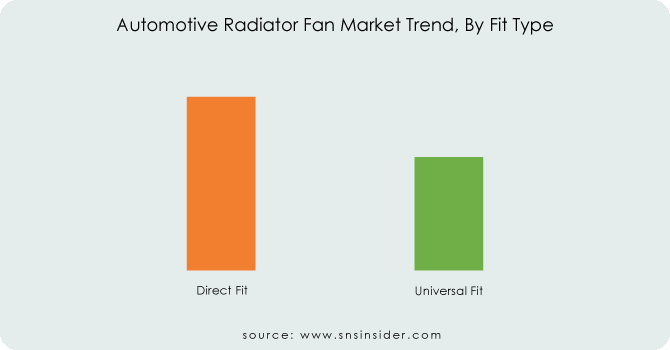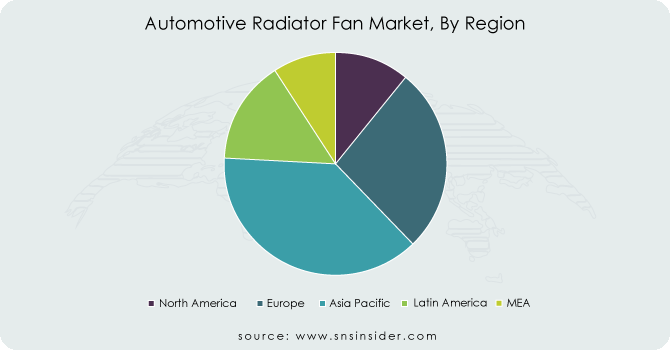Automotive Radiator Fan Market Report Scope & Overview:
The Automotive Radiator Fan Market Size was valued at USD 8.3 billion in 2023 and is expected to reach USD 12.72 billion by 2031 and grow at a CAGR of 5.48% over the forecast period 2024-2031.
Automotive Radiator Fan Market is becoming more important for overall engine temperature regulation. Automotive radiator fans keep airflow going through the radiator, especially at low speeds when natural airflow isn't enough. This market is expected to grow due to several reasons which are better cooling system designs, rising demand for SUVs in Asia Pacific, and rapid advancements in cooling tech. As the auto industry moves towards electric and hybrid vehicles, manufacturers are anticipated to develop cooling fan solutions specifically designed for these new types of cars. In short, the market for car radiator fans is expected to thrive due to a combination of factors including improved cooling systems, rising SUV popularity in Asia, and innovation in cooling technology. Additionally, the industry is expected to adapt and create new fan solutions for the growing market of electric and hybrid vehicles.

Get More Information on Automotive Radiator Fan Market - Request Sample Report
MARKET DYNAMICS:
KEY DRIVERS:
-
Drives demand for radiator fans and associated engine fan components.
-
The rise in sales of medium and heavy commercial vehicles (M&HCVs) is a contributing factor.
The expanding market for medium and heavy commercial vehicles, categorized as M&HCVs, positively impacts the demand for automotive radiator fans. These larger vehicles often generate more heat due to their size and function, requiring robust cooling systems. As a result, the growth in M&HCV sales translates to a need for more radiator fans, contributing to the overall market expansion.
RESTRAINTS:
-
Electric/hybrid vehicles' cooling tech may limit traditional radiator fan demand.
-
Antibacterial A/C systems could hinder growth in the radiator fan market.
OPPORTUNITIES:
-
Major players are fueling market expansion through new product launches and increased R&D efforts.
The automotive radiator fan market is being driven by innovation. Leading companies are investing in research and development to create new and improved fan designs. This focus on new technology, along with consistent product launches, is helping the market expand and offering customers more efficient cooling options for their vehicles.
-
To meet rising automotive demand, leading companies are establishing new manufacturing facilities in emerging markets.
CHALLENGES:
-
High power consumption and sensitivity to coolant chemicals can limit the use of certain radiator fan technologies.
-
Disruptions in the global supply chain can hinder the production and distribution of radiator fans.
IMPACT OF RUSSIA-UKRAINE WAR
The Russia-Ukraine war has disrupted the automotive radiator fan market. Disrupted supply chains are the most immediate consequence. The Ukraine being a supplier of raw materials and Russia a key player in certain metals, production of radiator fans has been slowed down. This shortage has led to price hikes for these essential components. Car manufacturers, already are struggling with post-pandemic chip shortages, now face additional pressure to find alternative sources for radiator fans. This can potentially delay vehicle production and ultimately impact consumer choice. The war could accelerate the development of more efficient and localized radiator fan production, making the market less vulnerable to future disruptions.
IMPACT OF ECONOMIC SLOWDOWN
An economic slowdown could affect the automotive radiator fan market. When consumer spending tightens, demand for new vehicles shrinks. This directly translates to fewer car parts being needed, including radiator fans. Furthermore, car manufacturers might prioritize cost-cutting measures, potentially delaying upgrades to incorporate the latest fan technologies. However, there could be a slight contrast as people hold onto their existing cars longer, the need for replacement parts like radiator fans might rise. With a focus on fuel efficiency during economic downturns, there could be a shift towards more advanced radiator fan designs that optimize engine cooling.
KEY MARKET SEGMENTS:
By Fit Type:
-
Direct Fit
-
Universal Fit
Direct Fit is the dominating sub-segment in the Automotive Radiator Fan Market by fit type with 65% market share. Direct fit fans are specifically designed for a particular vehicle model, ensuring a perfect fit and optimal performance. This ease of installation and guaranteed compatibility make them the preferred choice for most consumers and mechanics.

Need any customization research on Automotive Radiator Fan Market - Enquiry Now
By Material Type:
-
Steel
-
Aluminium
-
Composite
Aluminium is the dominating sub-segment in the Automotive Radiator Fan Market by material type with 70% market share. Aluminium offers a winning combination of lightweight construction, excellent heat dissipation, and resistance to corrosion. This makes it a superior choice compared to heavier steel fans and while composite materials are lighter, they may not offer the same level of durability or heat transfer efficiency.
By Vehicle Type:
-
Passenger cars
-
Commercial vehicles
-
Electric Vehicles
Passenger Cars is the dominating segment in the Automotive Radiator Fan Market by vehicle type with 55% market share. Passenger cars account for the largest share of vehicles produced and sold globally. This naturally translates to a higher demand for radiator fans specifically designed for these vehicles.
REGIONAL ANALYSES
The Asia Pacific is the dominating region in the automotive radiator fan market, capturing around 40% of the global market share. This dominance can be credited to the burgeoning automotive industry in nations like China and India.
Europe is the second highest region in this market holding around 30% of the market. This is driven by components like expanding disposable income, rising demand for passenger cars, , and developing government activities to promote electric vehicles, all of which require effective thermal management systems.

Regional Coverage
North America
-
US
-
Canada
-
Mexico
Europe
-
Eastern Europe
-
Poland
-
Romania
-
Hungary
-
Turkey
-
Rest of Eastern Europe
-
-
Western Europe
-
Germany
-
France
-
UK
-
Italy
-
Spain
-
Netherlands
-
Switzerland
-
Austria
-
Rest of Western Europe
-
Asia Pacific
-
China
-
India
-
Japan
-
South Korea
-
Vietnam
-
Singapore
-
Australia
-
Rest of Asia Pacific
Middle East & Africa
-
Middle East
-
UAE
-
Egypt
-
Saudi Arabia
-
Qatar
-
Rest of Middle East
-
-
Africa
-
Nigeria
-
South Africa
-
Rest of Africa
-
Latin America
-
Brazil
-
Argentina
-
Colombia
-
Rest of Latin America
KEY PLAYERS:
The major key players are Johnson Electric Holdings Limited (Hong Kong), Denso Corporation (Japan), Hella KGaA Hueck & Co. (Germany), Mahle GmbH (Germany), Standard Motor Products (US), Robert Bosch GmbH. (Germany), Valeo (France), BorgWarner Inc (US), Brose Fahrzeugteile SE & Co. KG (Germany), USUI Co. Ltd. (Japan), Delta Radiator Fan LTD. (Taiwan), ASMO CO, LTD (Japan), Nidec Corporation (Japan), Keihin Corporation (Japan), Toshiba Electronic Devices & Storage Corporation (Japan) and other key players.
RECENT DEVELOPMENTS:
-
In Oct 2022 - Nidec unveiled a new line of electric radiator fans designed with an innovative motor for lower energy consumption and better efficiency. This launch caters to the growing demand for eco-friendly and energy-saving solutions within the automotive industry.
Denso Corporation (Japan)-Company Financial Analysis

| Report Attributes | Details |
|---|---|
| Market Size in 2023 | US$ 8.3 Billion |
| Market Size by 2031 | US$ 12.72 Billion |
| CAGR | CAGR of 5.48% From 2024 to 2031 |
| Base Year | 2023 |
| Forecast Period | 2024-2031 |
| Historical Data | 2020-2022 |
| Report Scope & Coverage | Market Size, Segments Analysis, Competitive Landscape, Regional Analysis, DROC & SWOT Analysis, Forecast Outlook |
| Key Segments | • by Fit Type (Direct Fit, Universal Fit) • by Material Type (Steel, Aluminum, Composite) • by Vehicle Type (Passenger Cars, Commercial vehicles, Electric Vehicles) |
| Regional Analysis/Coverage | North America (US, Canada, Mexico), Europe (Eastern Europe [Poland, Romania, Hungary, Turkey, Rest of Eastern Europe] Western Europe] Germany, France, UK, Italy, Spain, Netherlands, Switzerland, Austria, Rest of Western Europe]), Asia Pacific (China, India, Japan, South Korea, Vietnam, Singapore, Australia, Rest of Asia Pacific), Middle East & Africa (Middle East [UAE, Egypt, Saudi Arabia, Qatar, Rest of Middle East], Africa [Nigeria, South Africa, Rest of Africa], Latin America (Brazil, Argentina, Colombia, Rest of Latin America) |
| Company Profiles |
Johnson Electric Holdings Limited (Hong Kong), Denso Corporation (Japan), Hella KGaA Hueck & Co. (Germany), Mahle GmbH (Germany), Standard Motor Products (US), Robert Bosch GmbH. (Germany), Valeo (France), BorgWarner Inc (US), Brose Fahrzeugteile SE & Co. KG (Germany), USUI Co. Ltd. (Japan), Delta Radiator Fan LTD. (Taiwan), ASMO CO, LTD (Japan), Nidec Corporation (Japan), Keihin Corporation (Japan), Toshiba Electronic Devices & Storage Corporation (Japan) |
| Key Drivers | • Drives demand for radiator fans and associated engine fan components.
• The rise in sales of medium and heavy commercial vehicles (M&HCVs) is a contributing factor. |
| RESTRAINTS | • Electric/hybrid vehicles' cooling tech may limit traditional radiator fan demand. • Antibacterial A/C systems could hinder growth in the radiator fan market. |

